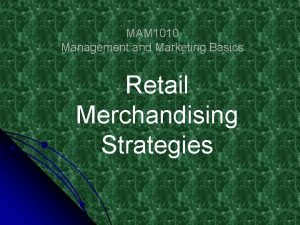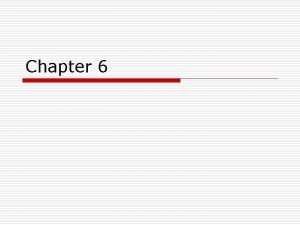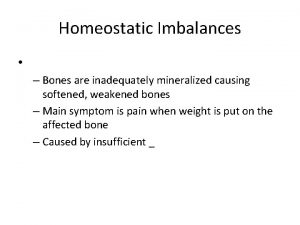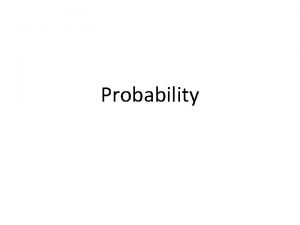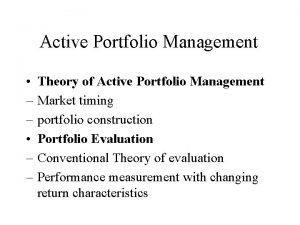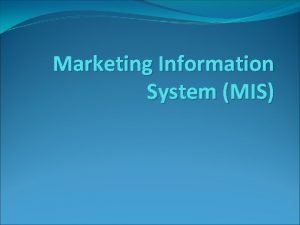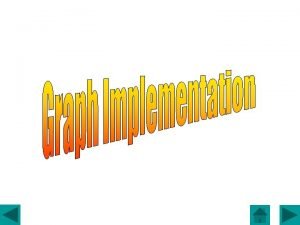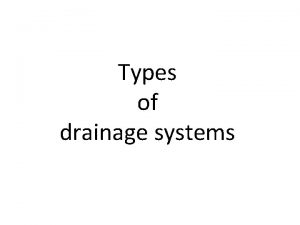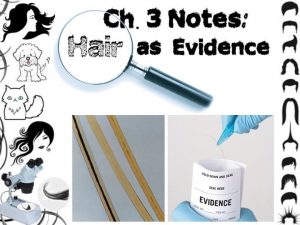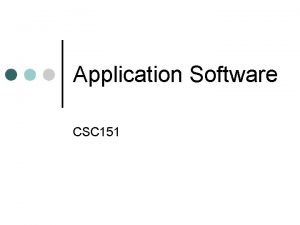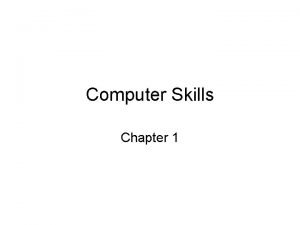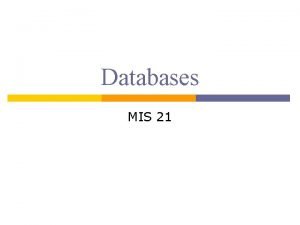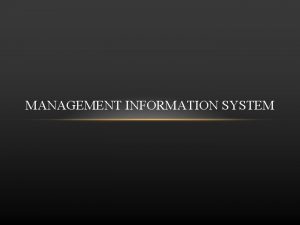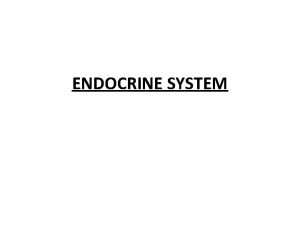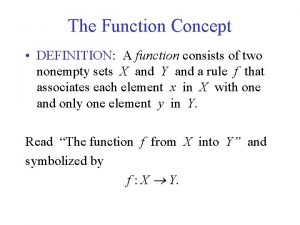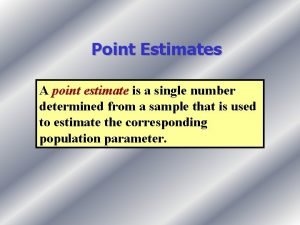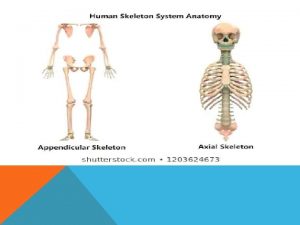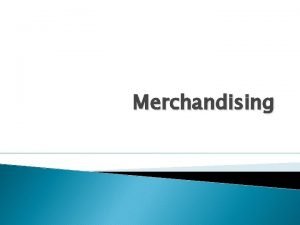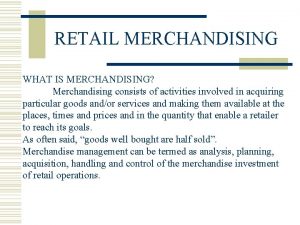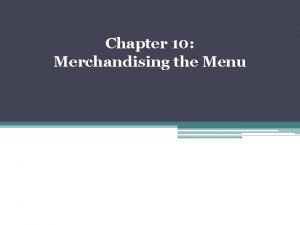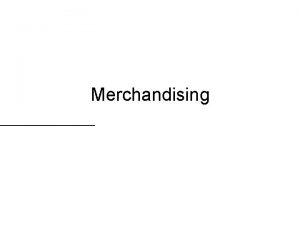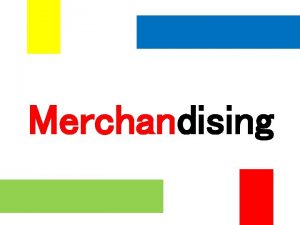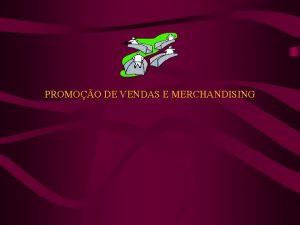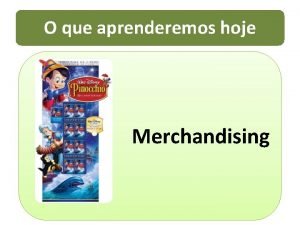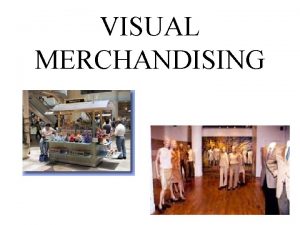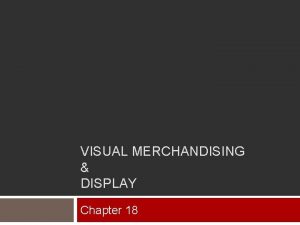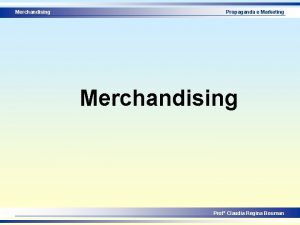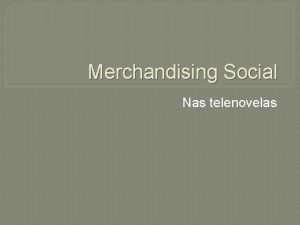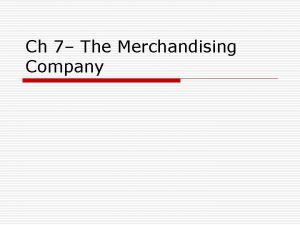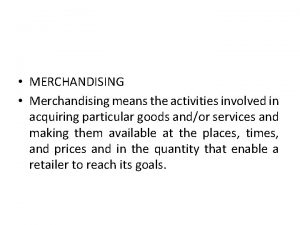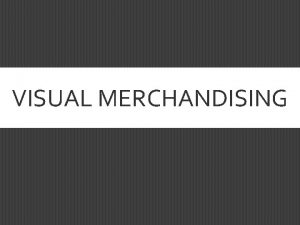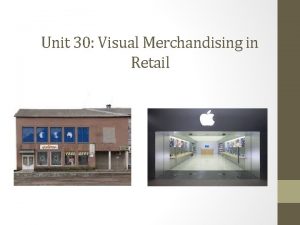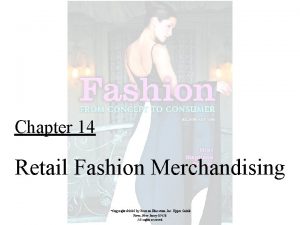RETAIL MERCHANDISING WHAT IS MERCHANDISING Merchandising consists of








































- Slides: 40

RETAIL MERCHANDISING WHAT IS MERCHANDISING? Merchandising consists of activities involved in acquiring particular goods and/or services and making them available at the places, times and prices and in the quantity that enable a retailer to reach its goals. As often said, “goods well bought are half sold”. Merchandise management can be termed as analysis, planning, acquisition, handling and control of the merchandise investment of retail operations.

EVOLUTION OF MERCHANDISING With rise in organized retail.

FACTORS AFFECTING THE MERCHANDISING FUNCTION Size of the Organization Structure Merchandising Function Type of Store Merchandise To be carried

ATTRIBUTES AND FUNCTIONS OF BUYING ORGANISATIONS Level of formality Formal/ Informal Degree of Centralization Centralized/ Decentralized Organizational Breadth General/ Specific Personnel resources Internal/ External/ Resident Buying Office/ cooperative Buying Functions Performed Merchandising/ Buying Staffing Buyer(buying only)/ Sales manager/ Buyer(merchandising)

FUNCTIONS OF A MERCHANDISE MANAGER They would be in charge of a group of buyers and their basic duties could be divided into planning, directing, coordinating and controlling. Planning: Though not directly involved in buying, they formulate strategies for the same. Forecasting the sales is done. These are then translated into budgets for buyers. Directing: Guiding and training buyers. Inspiring commitment and performance in buyers. Coordinating: Merchandise managers supervise work of more than one manager. Controlling: Buyers performance is evaluated on the basis of net sales, mark up percentage maintained, stock turns, etc.

FUNCTIONS OF A BUYER The typical responsibilities of a buyer are: 1. Developing the merchandising strategy for the product line he is responsible for. 2. Planning and selecting merchandise assortments. This requires a keen understanding of the current market trends and the economic developments. Understanding consumer wants and then locating of a product. 3. Vendor selection, development and management. Negotiations with vendors. 4. Pricing the merchandise. 5. Inventory management, allocation of merchandise to the various store locations. Controlling inventory so that ideally there is no non-stock situation. Mark downs and merchandise transfers.

DEVISING MERCHANDISE PLAN Forecasts Innovativeness Merchandise Plan Assortment Allocation Timing Brands

STEP 1 : DEVELOPING A SALES FORECAST Forecasts are projections of expected retail sales for given periods. Because retailers purchases are based on their sales expectations, forecasts are foundation of merchandise plans. They include these components: Overall company projections, product category projections, item by item projections and store by store projections. When planning forecasts, it is essential to distinguish among different types of merchandise: Staple Merchandise- Basic stock list Assortment Merchandise- Model stock Plan Fashion Merchandise- Seasonal Merchandise- Fad Merchandise Never out list for bestsellers forecasting.

FORECASTS……CONT…. . A sales forecast is usually made for a specific period of time. Short term or Long term. Process of developing Sales forecast: 1. Reviewing Past Sales 2. Analyzing the changes in the economic conditions 3. Analyzing the changes in Sales Potential 4. Analyzing the changes in the Marketing Strategies of the Retail Organization and the Competition. 5. Creating the Sales Forecast.

STEP 2 : DETERMINING THE MERCHANDISE REQUIREMENT Planning in merchandising is at two levels: 1. The Creation of the Merchandise Budget, and 2. The Assortment Plan There are two methods of developing a merchandise plan: Top Down Planning and Bottom Up Planning After sales forecasting, inventory levels needs to be planned. The merchandise budget usually comprises of five parts: 1. Sales Plan- department/ division/ store wise 2. Stock Support Plan 3. Planned Reductions 4. Planned Purchase Levels 5. Gross Margins

METHODS OF INVENTORY PLANNING THE BASIC STOCK METHOD: In this method the retailer carries more items than it expects to sell over a specified period. This gives the firm a cushion if sales are more than expected, shipments are delayed or customers wants to select from a variety of items. It is best when inventory turnovers are low and sales are erratic. Basic Stock = Average stock – Average monthly sales = Total planned sales Number of months Average stock = Total planned sales Estimated inventory turnover rate BOM stock = Planned monthly sales + Basic stock

INVENTORY PLANNING …. CONT……. THE PERCENTAGE VARIATION METHOD: This method is used when the stock turnover rate is more than 6 times a year. This method results in planned inventory closer to the monthly average. BOM stock = Average stock for season x ½ (1 + Planned sales for the month ) Average monthly sales THE WEEK’S SUPPLY METHOD: Retailers such as grocers who plan inventory on a weekly basis use this method. BOM stock = Average weekly sales x No. of weeks to be stocked = the number of weeks in that period stock turnover rate for that period Average weekly sales = Estimated total sales for that period the number of weeks in that period

INVENTORY PLANNING …. . CONT…… THE STOCK TO SALES RATIO METHOD: With this method the retailers wants to maintain a specified ratio of goods on hand to sales. This ration tells the retailer how much inventory is needed at the beginning of the month to support the month’s estimated sales. BOM stock = Stock-Sales ratio x Planned sales Stock-Sales ratio = Value of inventory Actual sales

INVENTORY PLANNING…. . CONT……. STOCK TURNOVER RATE: This is an effective measure of the speed with which the merchandise moves in and out of a retail store for a given period. Stock Turnover = Planned Sales Planned Average Inventory This is a measure of efficiency. From management perspective, this indicates the level of capital usage, i. e. , turning money to inventory and then repeating the process again.

INVENTORY PLANNING …. . CONT…… PLANNED REDUCTIONS: Planned reduction incorporate anticipated markdowns, employee and other discounts, stock shortages. It is important for the retailer to estimate and plan reductions instead of just waiting for them to occur. Planned Reductions = (Beginning inventory + planned purchase)(Planned sales + Ending inventory) Planned reductions revolve around two keys: estimating expected total reductions by budget period and assigning the estimates monthly. The following should be studied in planning total reductions: Past experience, markdown data for similar retailers, changes in company policies, merchandise carryover from one budget period to another, price trends, stock shortage trends.

STEP 3 : PLANNING PURCHASES The formula to calculate planned purchase for a period is: Planned purchase = Planned sales for the month + Planned (at retail) reductions for the month + Planned end of month stock – Beginning of month stock Planned purchase (at cost) = Planned purchase at retail x merchandise cost as a % of selling price OPEN TO BUY: is the difference between planned purchases and the purchase commitment already made by the buyer for a given period of time, often a month. It represents the amount a buyer has left to spend for that month and gets reduced each time a purchase is made.

PLANNING PURCHASES …. CONT…. . Open to buy = Planned purchases for the month- Purchase (at retail) commitments for the month Open to buy = Open to buy at retail x merchandise cost as a % of (at cost) selling price Open to buy has two significant strengths: first it assures the retailer that a specified relationship between stock on hand planned sales is maintained which avoids overbuying and under buying. Second, it lets the firm adjust merchandise purchases to reflect changes in sales, markdowns and so on. It is usually advisable for a retailer to keep at least a small open to buy figure for as long as possible. This enables the firm to take advantage of special deals, purchase new models and fill in sell outs.

PLANNING PROFIT MARGINS Required initial = Planned retail expenses + Planned profit + Markup % Planned reductions Planned net sales + Planned reductions Now that the merchandiser has an idea as to amount available to make the purchases, he needs to decide on the merchandise or the products that need to be bought. This is assortment planning.

GROSS MARGIN RETURN ON INVESTMENT GMROI is a merchandising planning and decision making tool that assist a buyer in identifying and evaluating whether an adequate gross margin is been earned by the products purchased, compared to the investment in inventory required to generate the gross margin. It focuses the buyers attention on ROI rather than on sales as a basis of merchandising decision. The focus is on SKU and not on department total and it helps identify product winners and core products. GMROI = Gross Margin Average Inventory at Cost

ECONOMIC ORDER QUANTITY Among the most useful techniques for determining how much to order is EOQ = 2 DS/IC D= annual demand in units, S= cost to place the order, I= inventory carrying cost expressed as % of value and C= unit cost of an item. Some usual objections to EOQ are: • Often inventory carrying cost and cost to place order cannot be identified accurately. • Supplier gets irregular stream of orders. • EOQ does not consider falling of demand • This model assumes that the unit cost is a constant.

STEP 4. ASSORTMENT PLANNING Retail assortment planning involves a determination of quantities of Each product that will be purchased so as to fit into the overall merchandise plan. Details of colour, size, etc are specified. The main purpose of assortment planning is to create a balanced assortment of merchandise for the customers. For Fashion merchandise: buying the right quantities at the right time is of great importance. Excess buying can lead to heavy markdowns and under buying might lead to not capitalizing on potential. For Staple/Basic merchandise: buying this category is relatively easier. For Seasonal merchandise: here timing of purchase is of extreme importance.

RETAIL ASSORTMENT STRATEGIES ADVANTAGES 1. WIDE & DEEP: • Broad market • full selection of items • High customer traffic • Customer loyalty • No disappointed customers DISADVANTAGES high inventory investment General image Many items with low turnover Some obsolete merchandise

RETAIL ASSORTMENT STRATEGIES…CONT…. ADVANTAGES 2. WIDE & SHALLOW • Broad market • High level of traffic • One stop shopping DISADVANTAGES Low variety within product lines Weak Image Disappointed customers Reduced Loyalty 3. NARROW & DEEP • Specialist Image No one stop shopping • Specialized personnel Little or no scrambled merchandise • Customer loyalty Susceptible to trends • No disappointed customers

RETAIL ASSORTMENT STRATEGIES…. CONT…. ADVANTAGES DISADVANTAGES 4. NARROW & SHALLOW • Convenient stores Little width/depth • High turnover of items Weak Image/ Disappointed customers • Least costly No one stop shopping Limited loyalty Little or no scrambled merchandise

ASSORTMENT PLANNING …. CONT…. . After taking decision on retail assortment strategy, merchandise works on assortment plan which includes product lines and brands in each product line. Thus after arriving at the amount of money available for investing in inventory, a merchandiser would have to determine the variety of merchandise. Example: MENS APPAREL STORE Factors like actual money available for buying, the target set by the management for inventory turnover, space available for stocking merchandise, market constraints, etc effect merchandise assortment plan.

MODEL STOCK PLAN What to buy and in what quantity leads to MODEL STOCK PLAN. To arrive at an accurate model stock plan, merchandiser needs deep understanding of consumer preference of attributes that he considers while buying. Then the merchandiser decides on the levels under each attribute and finally allocate money available to the respective item categories. STEP 1: Factors that affect consumer buying. STEP 2: Identify no of levels under each attribute, assign %s. STEP 3: Allocate total units to each category. EXAMPLE: MODEL STOCK PLAN FOR MEN’S APPAREL STORE: SHIRTS.

STEP 5: BRAND SELECTION Manufacturer Brands vs. Private Brands vs. Generic Brands Battle of Brands. STEP 6: TIMING When each type of merchandise is to be stocked. Retailer should take into account: forecasts, peak seasons, order and delivery time, routine vs. special orders, discounts, etc, . STEP 7: ALLOCATION Sales floor vs. sock room. Warehouses- central, regional and distribution centers.

CATEGORY MANAGEMENT Category management is a method of managing a retail business that focuses on product category results rather than the performance of individual brands or models. It arranges grouping of products into categories or strategic business units, so as to better meet consumer needs and achieve sales and profit goals. Category management orients retail managers towards merchandising decisions necessary to maximize the total return on assets assigned to them. A successful category management is predicated on 10 points: 1. Categories should be arranged as they would be if consumers could stock the shelves themselves. 2. Category configuration should be a function of time, space and product utilization.

CATEGORY MANAGEMENT…CONT…. 3. Category management should seek to drive multiple items purchases, not the selection of a single SKU from a like item category set. 4. Category management is a fluid, dynamic proprietary set of decisions, not a universal standard institutionalized practices. 5. The ultimate aim of category management is to create unique consumer value not just to bolster manufacturer- retailer sales. 6. A retailer’s category management plan ought to be based on overall trading area scenarios. 7. Category management is a exclusionary process as much a way of deciding what not to sell as what to sell to everyone. 8. The fundamental data base for category management should be drawn from a pre customer interface analysis of trading area needs.

CATEGORY MANAGEMENT …. CONT…. 9. The supplier’s goal is to make the most of purchases and margins within a given geographic area. The retailer’s goal is to raise total store or store cluster profitability and productivity. 10. Category management is a strategic differentiation.

COMPONENTS OF CATEGORY MANAGEMENT Performance Measurement Trading Partner Relationships Strategy Business Process Organizational Capabilities Information Technology

CATEGORY MANAGEMENT BUSINESS PROCESS Category Definition Category role Category Scorecard Category Assessment Category Strategy Category Tactics Plan Implementation

CAT. MGMT. BUSINESS PROCESS. . CONT. . 1. CATEGORY DEFINITION: should be based on how customers buy. It can vary from retailer to retailer. 2. CATEGORY ROLE: it determines the priority and the importance of the various categories in the overall business. This aids in resource allocation. Traditionally 4 categories have been identified: Destination Category: Fresh grocery at a Supermarket and Apparel at a Depart. . Store. Routine/ Preferred Category: Toothpaste, soaps, etc. Occasional/ Seasonal Category: Mangoes in summer for a supermarket and Raincoats in monsoon for a depart. Store. Convenience Category: Bread, Egg, routine stationary.

CAT. MGMT. BUSINESS PROCESS. . CONT. . 3. CATEGORY ASSESSMENT: here the current performance of the category is evaluated with respect to turnover, profits and ROI. It includes assessment of consumer, market, retailer and supplier. 4. CATEGORY PERFORMANCE MEASURE: this involves setting of measurable targets in terms of sales, margins, GMROI. 5. CATEGORY STRATEGIES: The purpose of this step is to help the retailer and supplier to develop strategies that capitalize on category opportunities through creative and efficient use of resources available. This aims at building traffic and transactions, getting cash, generating profits, enhancing image, creating excitement. 6. CATEGORY TACTICS: Assortment, pricing, promotion and presentation.

CAT. MGMT. BUSINESS PROCESS. . CONT. . 7. CATEGORY PLAN IMPLEMENTATION: Implementation schedule is developed and responsibilities are assigned. 8. CATEGORY REVIEW: Review the progress and actual achievement against target set. Review aids in taking decisions at the right point of time. ROLE OF CATEGORY CAPTAIN: Category captain is a supplier who aids the retailer in developing the category. Very often he is the leading manufacturer for the category. He is required too take an overall view of the category and create a plan for the category.

MERCHANDISE BUYING Merchandise Buying is a four step process: 1. Identifying the sources of supply 2. Contacting the sources of supply 3. Evaluating the sources of supply and 4. Negotiating the sources of supply. STEP 1: IDENTIFYING AND CONTACTING SOURCES OF SUPPLY: Central markets, trade shows, expositions. Supplier can be local or international, foreign. STEP 2: EVALUATING SOURCES OF SUPPLY: Potential vendors are evaluated. This is done on the basis of: Target market, Image of retail organization, Merchandise and prices offered, terms and services offered by vendor, vendor’s reputation and reliability.

MERCHANDISE BUYING… CONT…. The buyer then needs to negotiate on the price, the delivery dates, discounts, shipping terms and possibility of returns. Types of discounts that could be available to the buyer: Trade discounts, Chain discounts, Quantity discounts, Seasonal discounts, Cash discounts. STEP 3: ESTABLISHING RELATIONSHIPS WITH VENDORS: Importance of sharing sales forecast with suppliers. From suppliers side, new product launches, market share. Buyer needs to build on Mutual Trust, Open Communication, Common Goals and Credible Commitments.

MERCHANDISE BUYING… CONT…. STEP 4: ANALYSING VENDOR PERFORMANCE: This can be done by listing out the following: Total orders placed on the vendor in a year, total returns to the vendor, the quality of merchandise, the initial markup on the product, markdowns if any, participation of vendor in various schemes and promotions, transportation expenses if borne by the retailer, cash discounts offered by the vendor and lastly sales performance of the merchandise.

BRANDING STRATEGIES MANUFACTURER’S BRANDS: Also known as National Brands. Retailing national brands help in store image, increase the traffic flow and may reduce promotional expenses. Example: Pepsi, Coca cola, Nestle, Kellogg's, etc. LICENSED BRANDS: this is an arrangement in which the owner of a particular image sells the right to use the image or design to another party, typically a manufacturer. The licensee may be either: A retailer who contracts with a manufacturer to produce a licensed product or a third party who contracts to have the merchandise produces and then sells it to the retailer.

BRANDING STRATEGIES… CONT…. LICENSED BRANDS can be of several types: Character, Corporate, Designer name, Celebrity name, Nostalgia. PRIVATE LABEL BRANDS: It is a label unique to a specific retailer. Also known as store’s own brand. Generics were the first type of private labels to appear. Example: Wal-Mart 40% , Carrefour 33%, Niligiri’s 50%, Foodworld 29%, Subhiksha 20%, Lifestyle 20%, Westside 75%, Pantaloons 60%, etc.
 Types of retail organization structure
Types of retail organization structure Communication in retail management
Communication in retail management Types of display in visual merchandising ppt
Types of display in visual merchandising ppt Retail merchandising basics
Retail merchandising basics Assembly language consists of
Assembly language consists of Autonomic nervous system consists of
Autonomic nervous system consists of Method signature consists of
Method signature consists of Homeostatic imbalances of bones and joints
Homeostatic imbalances of bones and joints Organization consists of
Organization consists of Simple definition of motion
Simple definition of motion Multicellular exocrine glands can be classified
Multicellular exocrine glands can be classified What is muscle reading
What is muscle reading Costal cartilages join most ribs to the sternum.
Costal cartilages join most ribs to the sternum. Andreasen apparatus consists of hydrometer
Andreasen apparatus consists of hydrometer Roulette probability questions
Roulette probability questions Active portfolio management consists of
Active portfolio management consists of Mis meaning
Mis meaning A capacitor consists of
A capacitor consists of Graph consists of a?
Graph consists of a? One pipe system
One pipe system Middle layer and largest part of the hair shaft in humans
Middle layer and largest part of the hair shaft in humans In aquinas view man's ultimate happiness consists in
In aquinas view man's ultimate happiness consists in Concept of manpower planning
Concept of manpower planning Software consists of:
Software consists of: The course consists of
The course consists of Ur class
Ur class An automobile consists of
An automobile consists of A database consists of integrated tables which store
A database consists of integrated tables which store Introduction of mis
Introduction of mis Introduction of endocrine system
Introduction of endocrine system Nucleotide consists of
Nucleotide consists of Function in maths
Function in maths Food chain ladybug
Food chain ladybug Nimbus clouds gif
Nimbus clouds gif A point estimate consists of a single sample
A point estimate consists of a single sample Criteria for selecting brand elements
Criteria for selecting brand elements A slingshot consists of a light leather cup
A slingshot consists of a light leather cup Level a ensemble
Level a ensemble The appendicular skeleton consists of
The appendicular skeleton consists of Cpu consists of
Cpu consists of Ap physics energy
Ap physics energy



